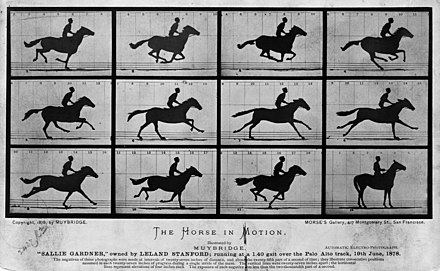Eadweard Muybridge Photographed a Trotting Horse in Rapid Succession to
Racing horses resemble hobby-horses with legs stretched forward and backward. Muybridge had to try to make a photograph that captured not just motion but incredibly rapid motion and though he succeeded well enough for Stanfords initial purposes yes the horse did have.

Eadweard Muybridge Stop Action Photographs Or Sequential Photographs 1877 Chronicles Of Animation
To determine if all four feet ever are off the ground Question 16 2 out of 2 points What much earlier work does Umberto Boccionis.

. Eadweard Muybridge photographed a trotting horse in rapid succession to. 1 photographic print. Series on left depicts a man riding a horse named Edgington trotting.
123 In her book River of Shadows 124 Rebecca Solnit tells Muybridges story in an exploration of what it was about 19th-century California that enabled it to become a centre of cultural and. To create a series of frames for a motion picture Correct Answer. He emigrated to the United States as a young man but remained obscure until 1868 when his large photographs of Yosemite Valley California made him world famous.
Inspired by Muybridges work the French scientist Étienne-Jules Marey built a camera that could shoot twelve frames in rapid succession onto a single piece of film. The honor is usually given to Eadweard Muybridge who in 1878 used 24 cameras to take a series of 24 pictures of a galloping horse. Asked Feb 3 2017 in Art Culture by Subaru.
Answer questions completely to receive full credit. Eadweard Muybridges photos of human bodies revealed his ____ attitude towards the human body. Twenty-four photographs were produced of consecutive movements of the trotting horse.
BRITISH 1830 - 1904 This important English photographer pioneered work in photographic studies of motion and in motion-picture projection. To determine if all four feet ever are off the ground Correct Answer. Muybridge was jailed and tried for murder the following year but was acquitted on the grounds of justifiable homicide.
The Horse in Motion is a series of cabinet cards by Eadweard Muybridge including six cards that each show a sequential series of six to twelve automatic electro-photographs depicting the movement of a horseMuybridge shot the photographs in June 1878. To determine if all four feet ever are off the ground. Racing horses keep at least one hoof on the ground at all times.
As the legend goes in 1872 the former California governor Leland Stanford asked the British photographer. To show that every tone was equal to every other Question 15 0 out of 2 points Why did Eadweard Muybridge photograph a trotting horse in rapid succession. Question 15 2 out of 2 points Why did Eadweard Muybridge photograph a trotting horse in rapid succession.
Muybridges experiments in photographing motion began in 1872 when the railroad magnate Leland Stanford hired him to prove that during a particular moment in a trotting horses gait all four legs are off the ground simultaneously. Five frames depicting Annie G a horse photographed by Muybridge were encoded in bacterias DNA using CRISPR genetic technology in 2017 90 of which proved recoverable. Viewed in rapid sequence this made the first motion picture.
By 1878 spurred on by Stanford to expand the experiments Muybridge had successfully photographed a horse at a trot. Stanford who was also a railroad tycoon and racehorse aficionado subscribed to the yet-unproven theory. Muybridge then used these photographs in a projection device he invented which he called a zoopraxiscope.
Eadweard Muybridge photographed a trotting horse in rapid succession to. On June 15 1878 a clear and sunny day in Palo Alto California amid a gathering of art and sports journalists Eadweard Muybridge photographed the first successful serial images of fast motion. As the horse trotted the wheels set off each camera in rapid succession as it crossed over the trip-wire.
Occident was attached to a small cart. An additional card reprinted the single image of the horse Occident trotting at high speed which had previously been. Remember to- Be specific.
Asked Apr 28 2017 in Art Culture. In 1878 Eadweard Muybridge photographed a galloping horse and discovered that. Who had become famous on the West Coast for his stunning photographs of the Yosemite Valley to help him settle an argument.
Muybridges experiments in photographing motion began in 1872 when the railroad magnate Leland Stanford hired him to prove that during a particular moment in a trotting horses gait all four legs are off the ground simultaneously. The German Die Brucke artists are associated with. 2 Muybridge blamed a severe head injury.
Series on right depicts a man riding a horse named Edgington walking. Photographer Eadweard Muybridge uses high-speed stop-motion photography to capture a horses motion. The irascible Muybridge born Edward James Muggeridge had to temporarily disband his motion-study work after shooting and killing Harry Larkyns his wifes lover in 1874.
He photographed the first ever sequential photographs which is now the iconic images in which became Muybridges life work. Asked Jul 10 2016 in Art Culture by Poppa. His first efforts were unsuccessful because his camera lacked a fast shutter.
The subject of these photographs was the trotting horse Abe Edgington harnessed to a sulky. Photograph shows two series of five consecutive images. Galloping horses occasionally have all four hooves off the ground.
Muybridges photography enabled scientists to study animal movement with exquisite clarity and artists to depict rapid motions such as that of racing horses more realistically. The photos prove that the horse has all four feet in. The Horse in Motion.
Determine if all four feet are ever off the ground at once.

June 15 1878 Muybridge Horses Around With Motion Pictures Wired


Comments
Post a Comment